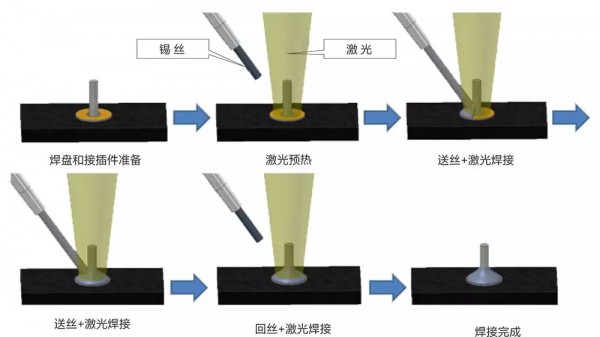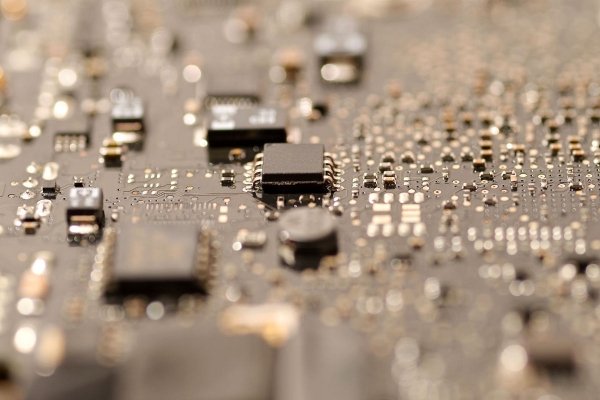How Laser Soldering Addresses Defects in Traditional PCB Soldering Processes
Traditional PCB soldering processes persistently face issues with defective solder joints, with new problems continually emerging in an overwhelming manner. Unlike laser soldering equipment that achieves high efficiency and superior yield, conventional methods struggle with consistent quality. Through systematic analysis, we have identified key patterns that help diagnose these recurring issues.
As an advanced soldering technology, laser soldering effectively resolves numerous defects inherent in traditional PCB processes (including wave soldering, reflow soldering, and manual soldering). It provides an optimized solution for manufacturing modern high-density, miniaturized, thermally sensitive, and mixed-technology circuit boards. Below is how laser soldering specifically addresses these conventional limitations:

Laser Wire-Feed Soldering Process Flow
Solving "High Thermal Stress/Thermal Damage" Issues:
Traditional Defects:
Wave soldering and reflow soldering require heating the entire PCB or large areas with high temperatures and prolonged durations, leading to:
Delamination and blistering in multilayer boards
Damage or performance degradation of heat-sensitive components (MLCC capacitors, sensors, connectors, plastic parts, FPC cables)
Warping deformation due to differences in thermal expansion coefficients
Laser Soldering Solution:
Laser energy is highly concentrated, enabling instantaneous and precise heating of microscopic solder joints with minimal heat input and an extremely narrow heat-affected zone.
Result:
Significantly reduces overall temperature rise, avoids large-area thermal shock, protects heat-sensitive components and substrate materials, minimizes thermal stress deformation, and improves product yield and long-term reliability.
Solving "Low Soldering Precision/Spatial Limitations" Issues:
Traditional Defects:
Wave soldering cannot process double-sided boards with bottom-side components and has poor selectivity for through-hole components.
Reflow soldering demands extremely high solder paste printing accuracy and stencil requirements, with bridging and cold solder risks increasing as pitch decreases.
Manual soldering precision depends on operator skill, resulting in poor consistency.
Difficulty soldering ultra-fine-pitch components (0402/0201 resistors/capacitors, fine-pitch BGA/QFN, CSP).
Inability to precisely solder specific joints in dense component arrays.
Inability to solder joints in deep cavities or confined spaces.
Laser Soldering Solution:
The laser beam can be focused to spots as small as tens of microns, achieving ultra-high positioning accuracy through precision optical systems and motion control (galvanometers/robots).
Result:
Enables easy soldering of ultra-small components, micro-pitch pads, joints in deep cavities, and precise targeting in dense component arrays without thermal or physical interference to adjacent parts, breaking through spatial limitations.
Solving "Poor Selectivity/Insufficient Flexibility" Issues:
Traditional Defects:
Wave/reflow soldering are "global" or "area" processes. They become inefficient and energy-wasting when:
Different joints require different parameters (temperature/time).
Only a few joints need soldering on a board.
Mixed-technology boards (SMT+THT) require complex processes.
Laser Soldering Solution:
Inherently a non-contact spot or localized soldering method. Programs can independently control each joint's energy, duration, and path.
Result:
Achieves true "selective soldering," allowing different parameters for different joints on the same board. Particularly suitable for:
Reworking individual solder joints.
Soldering a small number of through-hole components (connectors, large capacitors).
Soldering only the required post-assembly parts on mixed-technology boards.
Soldering irregular or hard-to-secure components.
Dramatically improves production flexibility.

4. Addressing "Solder Balling/Splashing/Bridging and Other Process Defects"
Traditional Defects:
Wave soldering prone to solder balls and bridging (especially with fine-pitch components)
Reflow soldering highly sensitive to solder paste volume, printing accuracy and temperature profiles - often causing solder balls, tombstoning, cold joints, bridging and solder beads
Laser Soldering Solution:
Precise solder dosage control: Integrated with precision wire/cream feeding systems for accurate solder volume per joint
Localized precision heating: Highly controlled melting process with rapid, accurate heat input and short molten pool duration
Visual process monitoring: Easily integrates coaxial temperature monitoring for real-time closed-loop control
Results:
Significant reduction in solder balls and splashing
Effective prevention of bridging, especially in high-density interconnect areas
Improved joint consistency and yield
Real-time monitoring ensures stable welding quality
5. Solving "Difficult Rework/Secondary Damage" Issues
Traditional Defects:
Rework (particularly for BGA/QFN bottom-terminated components) typically requires hot air guns or rework stations, causing thermal shock to surrounding components and risking damage to adjacent parts or PCB
Laser Soldering Solution:
Laser's precise positioning and minimal heat-affected zone make it ideal for rework
Results:
Precisely heats individual or small groups of target joints
Easily removes old solder and applies new solder
Negligible thermal impact on surrounding components and PCB
Greatly reduces rework risks and costs
6. Addressing "Flux Residue/Cleaning Issues"
Traditional Defects:
Wave/reflow soldering typically requires substantial flux (rosin-based, no-clean, etc.), where residues may affect reliability, appearance or subsequent processes (e.g., bonding, coating)
Laser Soldering Solution:
Can use low-residue or residue-free liquid flux or specially formulated solder wire
Requires less flux with better control
Laser heat effectively decomposes certain residues
Results:
Significant reduction in flux usage and residue
Lower cleaning costs and environmental impact
Improved product cleanliness
7. Solving "Process Consistency Dependent on Operators/Equipment Status"
Traditional Defects:
Manual soldering quality heavily dependent on operator skill and condition
Wave/reflow stability affected by equipment maintenance, conveyor speed, oven temperature uniformity, environment, etc.
Laser Soldering Solution:
Fully digital, programmable control of welding parameters (power, duration, spot size, path) with easy integration of process monitoring and feedback
Results:
Achieves extremely high process consistency and repeatability
Reduces human factor influence
Facilitates data tracking and process optimization
Summary:
Laser soldering revolutionarily addresses inherent defects of traditional processes in thermal damage, precision, selectivity, process defects, rework, cleanliness and consistency through its core advantage of highly localized, precisely controllable heat input. It is particularly suitable for:
High-density interconnect boards: Micro-pitch component soldering
Boards with heat-sensitive components: Protects sensors, MLCCs, connectors, etc.
Flexible/rigid-flex boards: Prevents delamination or deformation from thermal stress
Mixed-technology boards: Efficient selective soldering of through-hole components
Miniaturized products: Wearables, micro sensor modules, etc.
High-reliability applications: Automotive, aerospace, medical electronics
Rework applications: Precise, low-risk solder joint repair

Songsheng Optoelectronics' semiconductor constant-temperature coaxial monitoring welding head, equipped with a PID online temperature regulation feedback system, effectively achieves constant-temperature soldering while ensuring high yield and precision. The temperature control principle of Songsheng's laser soldering system operates through infrared detection that monitors the target's thermal radiation in real-time, creating a closed-loop control between welding temperature and detected temperature. The company's self-developed control board with PID regulation functionality maintains laser welding temperature within set parameters with minimal fluctuation.
As laser equipment costs decline, automation integration improves, and processes mature, laser soldering is increasingly becoming a critical technology for addressing traditional welding challenges while enhancing electronic manufacturing capabilities and product quality. The system's core advantages - including localized energy application, precise thermal control, and programmable parameters - position it as an ideal solution for modern high-density, miniaturized, and thermally sensitive electronic assemblies across industries ranging from consumer electronics to automotive and medical applications.
Contact: Mr.Xiao
Phone: +86-13385280662
E-mail: market001@whlaser.cn
Add: Room 02, Floor 5, Building 9, Gezhouba Sun City, No. 40, Gaoxin 4th Road, Donghu New Technology Development Zone, Wuhan